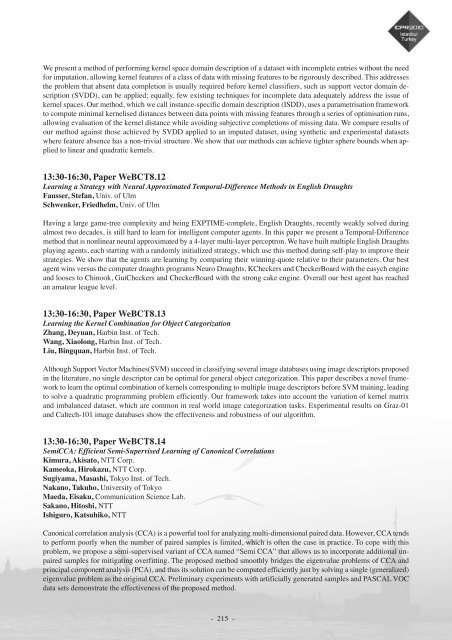Abstract book (pdf) - ICPR 2010
Abstract book (pdf) - ICPR 2010
Abstract book (pdf) - ICPR 2010
- TAGS
- abstract
- icpr
- icpr2010.org
Create successful ePaper yourself
Turn your PDF publications into a flip-book with our unique Google optimized e-Paper software.
We present a method of performing kernel space domain description of a dataset with incomplete entries without the need<br />
for imputation, allowing kernel features of a class of data with missing features to be rigorously described. This addresses<br />
the problem that absent data completion is usually required before kernel classifiers, such as support vector domain description<br />
(SVDD), can be applied; equally, few existing techniques for incomplete data adequately address the issue of<br />
kernel spaces. Our method, which we call instance-specific domain description (ISDD), uses a parametrisation framework<br />
to compute minimal kernelised distances between data points with missing features through a series of optimisation runs,<br />
allowing evaluation of the kernel distance while avoiding subjective completions of missing data. We compare results of<br />
our method against those achieved by SVDD applied to an imputed dataset, using synthetic and experimental datasets<br />
where feature absence has a non-trivial structure. We show that our methods can achieve tighter sphere bounds when applied<br />
to linear and quadratic kernels.<br />
13:30-16:30, Paper WeBCT8.12<br />
Learning a Strategy with Neural Approximated Temporal-Difference Methods in English Draughts<br />
Fausser, Stefan, Univ. of Ulm<br />
Schwenker, Friedhelm, Univ. of Ulm<br />
Having a large game-tree complexity and being EXPTIME-complete, English Draughts, recently weakly solved during<br />
almost two decades, is still hard to learn for intelligent computer agents. In this paper we present a Temporal-Difference<br />
method that is nonlinear neural approximated by a 4-layer multi-layer perceptron. We have built multiple English Draughts<br />
playing agents, each starting with a randomly initialized strategy, which use this method during self-play to improve their<br />
strategies. We show that the agents are learning by comparing their winning-quote relative to their parameters. Our best<br />
agent wins versus the computer draughts programs Neuro Draughts, KCheckers and CheckerBoard with the easych engine<br />
and looses to Chinook, GuiCheckers and CheckerBoard with the strong cake engine. Overall our best agent has reached<br />
an amateur league level.<br />
13:30-16:30, Paper WeBCT8.13<br />
Learning the Kernel Combination for Object Categorization<br />
Zhang, Deyuan, Harbin Inst. of Tech.<br />
Wang, Xiaolong, Harbin Inst. of Tech.<br />
Liu, Bingquan, Harbin Inst. of Tech.<br />
Although Support Vector Machines(SVM) succeed in classifying several image databases using image descriptors proposed<br />
in the literature, no single descriptor can be optimal for general object categorization. This paper describes a novel framework<br />
to learn the optimal combination of kernels corresponding to multiple image descriptors before SVM training, leading<br />
to solve a quadratic programming problem efficiently. Our framework takes into account the variation of kernel matrix<br />
and imbalanced dataset, which are common in real world image categorization tasks. Experimental results on Graz-01<br />
and Caltech-101 image databases show the effectiveness and robustness of our algorithm.<br />
13:30-16:30, Paper WeBCT8.14<br />
SemiCCA: Efficient Semi-Supervised Learning of Canonical Correlations<br />
Kimura, Akisato, NTT Corp.<br />
Kameoka, Hirokazu, NTT Corp.<br />
Sugiyama, Masashi, Tokyo Inst. of Tech.<br />
Nakano, Takuho, University of Tokyo<br />
Maeda, Eisaku, Communication Science Lab.<br />
Sakano, Hitoshi, NTT<br />
Ishiguro, Katsuhiko, NTT<br />
Canonical correlation analysis (CCA) is a powerful tool for analyzing multi-dimensional paired data. However, CCA tends<br />
to perform poorly when the number of paired samples is limited, which is often the case in practice. To cope with this<br />
problem, we propose a semi-supervised variant of CCA named “Semi CCA” that allows us to incorporate additional unpaired<br />
samples for mitigating overfitting. The proposed method smoothly bridges the eigenvalue problems of CCA and<br />
principal component analysis (PCA), and thus its solution can be computed efficiently just by solving a single (generalized)<br />
eigenvalue problem as the original CCA. Preliminary experiments with artificially generated samples and PASCAL VOC<br />
data sets demonstrate the effectiveness of the proposed method.<br />
- 215 -



